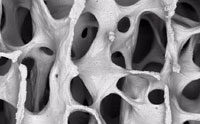Looking for the clearest amber on Earth? A new study shows that Dominican Republic amber is clear enough to see what’s inside. Apparently, ancient parasitic protozoans loved to live inside intact red blood cells. More… …read more Read more here: icr.org
By Tom Hennigan Forests are nurseries of health and well-being. New discoveries are showing that this doesn’t happen by accident. The trees are working together. …read more Read more here: AIG Daily
River trout have been found with amazing resistance to toxic pollutants but this turns out to be in-built. …read more Read more here: creation.com
A new study demonstrates that adult-like nervous system patterns exist throughout the early stages of human development, even in the hands and feet. These results add to the increasing evidence that aborted babies experience severe traumatic pain during all stages of pregnancy. More… …read more Read more here: icr.org
The traditional evolutionary model states that organisms evolve by random mutations. These mutations somehow provide new genetic information leading to novel traits that can be selected upon by the environment. Now, a new study shows mutations that commonly arise during cell division are not only unhelpful, but instead are highly correlated with cancer. More… …read more Read more here: icr.org
By Ken Ham One of our supporters recently sent us a photo of an exhibit at a major US metropolitan zoo. The sign at this exhibit says that dolphins were both “designed for the depths” and “perfectly adapted for life in the water.” Since apparently it’s National Dolphin Day today (April 14), I thought I’d share the photo with you. Evolutionists often try to explain evolution by claiming that the evolutionary process supposedly designed a particular creature for its environment. But naturalistic evolutionary processes are random and purposeless—they couldn’t design anything. And what about adaptation? Well, what they mean …read [More]
Three of the seven planets orbiting Trappist-1, are said by NASA to be in the habitable zone; however, research shows that neither life nor even water have been found there. …read more Read more here: creation.com
By John UpChurch Your eye’s complex ability to see color and motion points to the Creator. Even its limitations reveal His purposeful design. …read more Read more here: AIG Daily
By Dr. Andrew A. Snelling Although many people think radiocarbon is used to date rocks, it is limited to dating things that contain carbon and were once alive (fossils). …read more Read more here: AIG Daily
18th century skeptic David Hume formulated some of the most famous arguments against design. Do they stand us under scrutiny? …read more Read more here: creation.com
Mutations cause variety in the coat colours of animals. These mutations are all ‘downhill’, in the wrong direction for mutations to make microbes-to-man evolution feasible. …read more Read more here: creation.com
By Dr. Elizabeth Mitchell Are human feet the foundational distinction between knuckle-walking apes and us? How did we learn to walk this way? …read more Read more here: AIG Daily
Were creatures designed with genomic plasticity to enable them to adapt as they reproduced and filled the earth? …read more Read more here: creation.com
By Dr. Andrew A. Snelling The idea that continents move sounds crazy . . . until you look at the facts. …read more Read more here: AIG Daily
This mammal with a leathery armour was once rare in Texas, but its ‘conquest’ of that state-and beyond-conveys a strong message. …read more Read more here: creation.com
A mathematical solution challenges the need for scientists to invoke dark matter to solve problems in astrophysics and cosmology. …read more Read more here: creation.com
How does one build a structural material that withstands stress and fracture? The answer is to copy optimal designs from living systems because they far exceed man’s ingenuity. Recently, an improved steel was developed by copying human bones. More… …read more Read more here: icr.org
The old seafarers’ tales should not have been dismissed. Many species of squid can, and do, fly. …read more Read more here: creation.com
By Avery Foley A frog’s ability to grab and eat such a variety of food—and so quickly—is a testament to the creativity of the Designer. …read more Read more here: AIG Daily
A 15-year-long project finally bore fruit after researchers painstakingly identified a specific gene mutation that can lead to sudden heart failure in otherwise healthy-looking young people. These newly published results counter the long-standing view that mutations can somehow drive evolutionary innovation. More… …read more Read more here: icr.org
Prof. Cox’s alternatives for the end of the universe are maximum disorder or maximum blowup. The future according to the Bible involves re-creation of the Earth, and universal Judgment by God. …read more Read more here: creation.com
Have people really found skeletons of giants? …read more Read more here: creation.com
We reveal the scientific problems with Cox’s claims regarding the big bang, the CMB, the horizon problem, the flatness problem, faster-than-light inflation, an eternal universe, and a multiverse. …read more Read more here: creation.com
By Dr. Andrew A. Snelling NCSU’s recent research revealed an “oversight in a radioisotope dating technique used to date everything from meteorites to geologic samples.” …read more Read more here: AIG Daily
Exploring the possibility that long-age radiometric dating correlates to biblical earth history. …read more Read more here: creation.com
“More marvels of design that we are supposed to believe were the product of random chance processes … yeah, right.” Admin Scuba divers can explore underwater depths firsthand because of specialized equipment that was developed in just the last century. Likewise, solar-powered airplanes currently in development promise to provide fuel-free flying. These inventions open new realms for human exploration, but the arachnid and insect equivalents of their equipment have been on the planet for ages. Scuba is a stand-alone word today, but it began as the acronym for “self-contained underwater breathing apparatus,” so named because it supplies breathable air underwater. [More]
Scientists are discovering engineering details of the biological structures that enable some animals to jump exceedingly far for their sizes. Froghoppers are insects that can jump 100 times their body length, and it turns out that sheer muscular strength is not nearly sufficient to account for this feat. Read More: Insect Designed with a Spring in Its Step | The Institute for Creation Research












































